What will you need to know if you want to survive in a post SHTF world?
This article will answer that question by referencing skills that were common amongst our forebears living in the 18th century. But before I give you a list of skills you need to master, I need to talk about the 18th-century survival mindset.
You will often hear someone say that people nowadays are soft. And that we couldn’t survive out in the wild on our own. That may be partially true, in particular, as it refers to mindset.
You probably know more about surviving than you realize, but do you have the right mindset?
The loss of knowledge about how to survive is real. But what I see today is a loss of common sense, a lack of daring, and an absence of initiative.
Home Alone
18th Century people didn’t harbor the expectation that someone else was on their way to save them. They were on their own and understood that they were responsible for their survival.
Related: 12 Pioneer Skills We Can’t Afford to Lose
Common Sense
18th Century people lived by common sense. Any animal can be eaten, including dogs, cats, snakes, and even bugs.
Modern people rarely apply common sense. Believing if they don’t have access to modern solutions, then there is nothing to be done.
Let’s suppose you need to treat a cut but have no antiseptic? What about whiskey, salt, bleach, or even a searing hot piece of wire to sterilize and cauterize the wound?
Lack Of Daring
If you can only do what you have been taught, you will be in for a rough time in a world where you can’t call someone or Google for a solution.
In my mind, lack of daring refers to trying things that no one has taught or shown you. Can you find your way? Can you figure something out? A pioneering spirit is all about finding a way where none currently exists. A willingness to keep failing but also keep trying is required.
Absence Of Initiative
18th Century people knew that no one was coming to save them. They understood that surviving was their responsibility, and as such, didn’t wait around for instructions.
There was no one to tell them what to do. 18th Century people had to seize the initiative and assume responsibility for themselves.
It’s your fault if you freeze to death or have nothing to eat. You need to set the ball in motion.
18th Century Skill Set
Here are a few suggestions on what every prepper should learn or have.
#1. A Practical Walking Staff
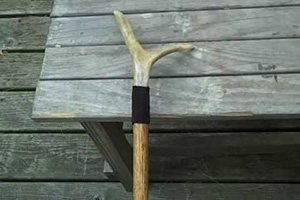 You must have a walking staff. The most practical solution is a staff that has a sharp point on one end, and a Y shape on the other. This is the most useful staff possible.
You must have a walking staff. The most practical solution is a staff that has a sharp point on one end, and a Y shape on the other. This is the most useful staff possible.
Firstly, both the sharp point and the Y-shaped end can serve as a defensive weapon, protecting against both people and animals.
Animals that have been wounded or trapped can be pinned to the ground with the Y section.
The sharp end can be driven into the ground and used as a tentpole. You can also push it into soft soil and hang a satchel or small bag on the Y section, keeping food or clothes off the ground.
The staff can also be used as a shooting stick while hunting, or rested against a tree and covered with a camo cloth to create a small shelter or hide.
Your walking stick can be used as a flagstaff if you need to signal someone. Another practical use is as a crutch that can support your weight in case of a serious leg injury. A cloth wound around the y-section will enable the stick to be placed under the arm, supporting maximum weight.
The ideal thickness is around 1″ to 1,5″ inches. The ideal height is just below your arm. (If you want to use it as a shooting stick or crutch.) Fire can be used to harden the sharp point.
#2. Estimating The Time Till Sunset
If you are out in the wilderness you need to know how much time you have till it gets dark.
The best technique is to use your hand at arm’s length, palm toward you. Your fingers must be held horizontally. Now measure how many hands/fingers between the horizon and the bottom of the sun.
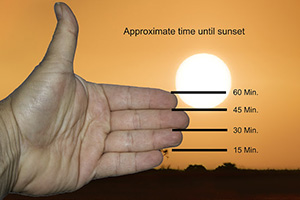
Every full hand is about one hour, and every finger about 15 minutes. This is only a rough estimate, as the time of year and width of hands differ.
But still, if the sun is two hands and two fingers above the horizon, you have roughly two and a half hours till sunset. I would work for two hours just to be safe.
#3. The Distance You Can Cover In An Hour
On a flat surface, along a reasonably well-maintained path, the average person can walk between 3 and 4 miles per hour.
Forests, mountains, deserts, and even alongside the sea on the beach will be slower going. Thick forest or rocky mountainous terrain can slow you down to between 3/4 to 1 mile per hour.
Related: Edible and Non-edible Mushrooms you Find in Forests
Use this in conjunction with estimating time till sunset when moving around outside.
#4. Maintain Direction While Walking In A Forest
I write this assuming you have no compass, GPS, or watch and that there is no sun by which you can navigate. Maintaining direction when you can’t see the sun and have no navigation tools is more difficult than most people think.
Some would say it’s impossible. But if you have to try, this is the best advice.
Don’t trust your inner sense of direction. Rather, have a sound strategy based on reason.
Method 1 – Marker To Marker
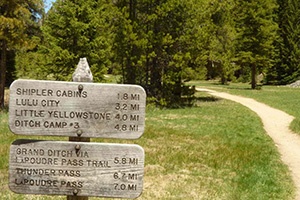 Try to move from marker to marker. Gauge the direction you want to move in. Look ahead and find a tree, rock, or landmark to focus on. Walk to that tree or landmark.
Try to move from marker to marker. Gauge the direction you want to move in. Look ahead and find a tree, rock, or landmark to focus on. Walk to that tree or landmark.
Then, using your starting position and current position, mentally trace a line and identify a new focus point ahead.
This will be tedious and slow going but will keep you in an approximate straight line. You can use broken branches at your starting point and waypoints to help you maintain a straight line.
Method 2 – Navigate With Moss
Another way of doing this is to use moss to navigate. In the Northern Hemisphere, moss grows on the north side of trees. This can keep you going in the approximate direction that you want to head.
If you want to head east, the main growth of moss on trees must consistently be on your right-hand side, etc.
Method 3 – Use The General Slope
This will work on mountains, and also only if you know the general lay of the land.
If you follow the slope straight up or straight down, you will be walking in more or less in a straight line or general direction.
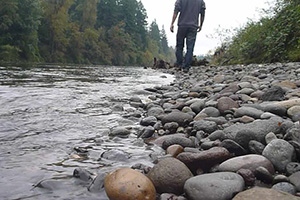
Walking horizontally along a mountain will take you in the direction that the mountain lies, east-west or north-south, or in whichever direction the range stretches. Don’t try this on a round outcropping, as you will end up where you started.
If you find yourself walking downwards, then level, then later you’re heading upwards, then down again, the chances are good that you are walking in a circle or a curve.
Related: How I Survived Alone for 10 Months Living Off the Land
Method 4 – Passing Left Then Right
The last method is speculative at best but may keep you from walking in circles. The theory is that while walking in a forest, there will often be a tree directly in our path.
If you keep on passing to the left of every tree in your path, you will trace a circle. But, if you alternate passing to the left and to the right of trees that lie roughly in your path, you would trace a straighter line than when passing every tree on the same side.
The best is to try and navigate using the sun or moon or large visible beacons.
#5. Sling
This easy to make object can be used quite successfully to propel stones at high velocities, and can be used to hunt birds and small animals.
In the bible, David killed Goliath with the sling he used to drive predators away from his flock of sheep. A sling is easy to make.
You Will Need
A length of rope or twine, even animal hide can be used. A length of between 4 and 6 feet will work best.
You will need a leather patch to put hold the stone. The size of the patch should be about half the size of your palm.
Next Steps
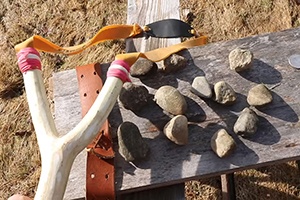 Cut the patch into an oval shape. Then cut two small slits close to the thin/sharp ends of the oval.
Cut the patch into an oval shape. Then cut two small slits close to the thin/sharp ends of the oval.
Run the rope through the tow slit of the patch, positioning the paths roughly in the middle. You need to tie a loop onto one end of the rope. Make sure that the loop must is large enough to insert your last two fingers through
How To Use
To propel a stone, you insert your two fingers through the loop and place the other end of the rope in the same hand. Now make a fist and hold both ends tight.
Next, enclose the stone within the patch, ( rope on the outside, stone cradled inside) and then slide the patch until it’s in the middle of the rope (The furthest position possible from your hand.)
You can now start swinging the rope in a circular motion above your head. To “Fire”, just open your hand to release the loose end.
Aiming with the sling involves letting go of the rope a few instances before the stone points in the direction you want it to go in. You will need to practice this.
Lastly. You don’t need to twirl the sling tens of times. Keep it in motion while you find the object you want to throw at. Once you have it spotted, speed the sling up vigorously and release it. Two or three spins overhead should do.
Trial And Error
Lastly, it’s never prudent to field test skills for the first time when your life depends on getting it right. Try and put the above into practice whenever the opportunity presents itself.

No comments:
Post a Comment